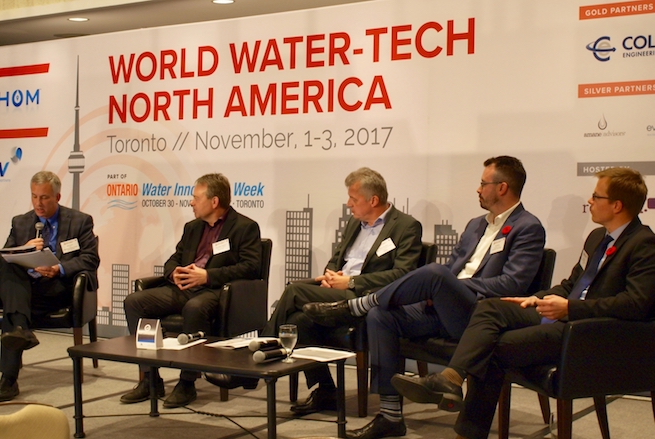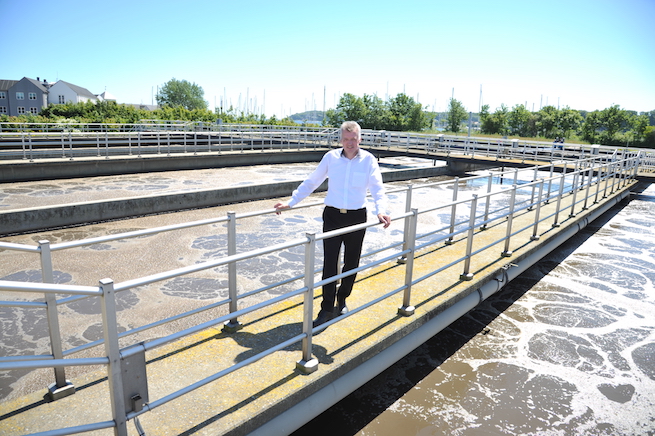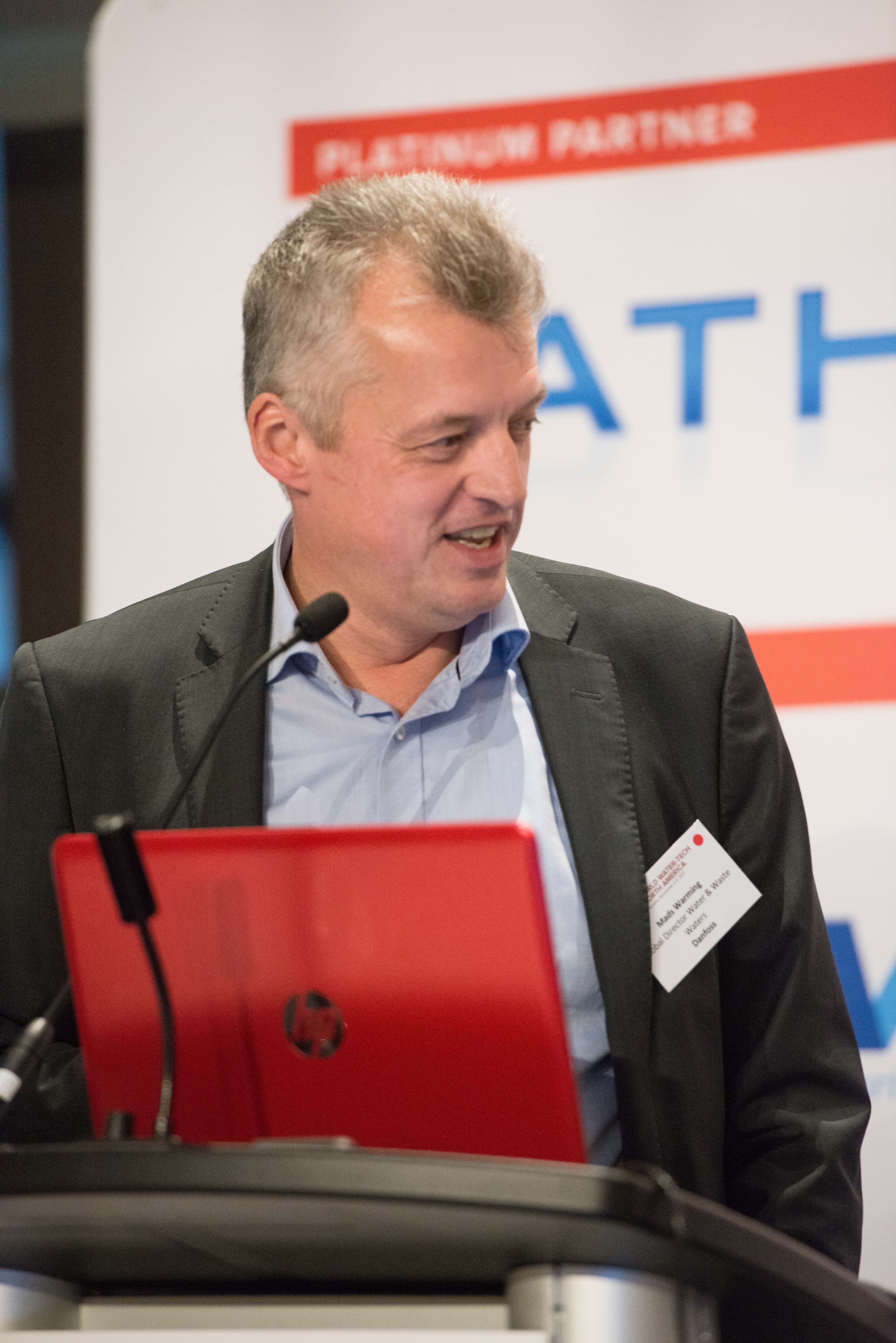
Energy neutral wastewater services
May 28, 2018
By
Doug Picklyk
Tapping efficiencies and turning wastewater treatment into energy production.

Panel discussion, “A New Paradigm for Utilities,” (l-r): Adam Krantz (moderator); Claus Moller Pedersen, Aarhus Vand; Mads Warming, Danfoss; Pat Whalen, Luminultra; and Jeff Peters, Suez.
(article first appeared in May 2018 Canadian Consulting Engineer)
Municipalities around the world are rethinking the way wastewater is managed, and by incorporating energy-saving efficiencies combined with the power generating potential within this waste stream they’re driving down costs for citizens while providing an essential service.
In November 2017, water services professionals from across North America and Europe gathered in Toronto to share innovations and smart approaches to elevating the effectiveness of the water industry.
World Water-Tech North America, a two-day conference held in conjunction with Ontario Water Innovation Week, featured multiple emerging technologies, with one specific session focusing on energy and resource recovery opportunities in wastewater facility design and operations.
Called “A New Paradigm for Utilities,” the session included a case study of a Danish wastewater plant that operates energy neutral along with presentations on technologies and processes that can move more facilities on to that same net-zero reality for these typically high-energy consuming operations.

Mads Warming of Danfoss at the energy-neutral Marselisborg wastewater treatment plant in Aarhus, Denmark. (Photo: courtesy Danfoss)
Danish design – energy neutral water cycle
Claus Moller Pedersen, chief project officer with Aarhus Vand (a public utility company owned by the municipality of Aarhus in Denmark), spoke about how his company has successfully flipped the traditional high-cost formula at its Marselisborg wastewater treatment plant. The facility actually generates more energy than it consumes.
Pedersen opened the “New Paradigm” session with a review of his plant, which services a portion of Aarhus, the second-largest city in Denmark.
Charting a period of 26 years (1990 to 2016), he illustrated the plant’s declining power consumption and increasing power production history. The plant uses an anaerobic digestion system to treat the waste sludge, turning that resource into biogas to fuel a combined heat and power (CHP) system. And over a number of years the facility has been incorporating energy-saving efficiencies, including sensor-driven process control (a supervisory control and data acquisition “SCADA” system) along with some 290 variable frequency drive (VFD) pumps and blowers installed in the catchment area including water and wastewater pumping and wastewater treatment.
Since early 2011 the facility has been operating energy neutral, and now produces more than double the energy it consumes, with enough surplus to cover the energy required to provide drinking water to its 200,000 citizens.
The plant sends excess heat to the local district heating system and surplus electricity to the grid. Biosolids extracted from its digester are also hauled off to support the agriculture industry.
Based on this success, the region is now seeking to develop the world’s most resource-efficient wastewater treatment plant, calling it Marselisborg ReWater.
Engineering efficiency
Also speaking at the event was Mads Warming, global director, water and wastewater with Danfoss. Having worked with the Marselisborg facility, Warming notes that the systems used in Aarhus can be adopted in both existing facilities and when building new.

“We are taking the biggest asset for these water services companies, which is the concrete and all of the pipe they have in the network, and we make that more intelligent,” Mads Warming, Danfoss. (photo courtesy Rethink Events)
“Once you understand the processes, it should be relatively easy for a plant to replicate what has been done in Denmark,” he says. The Aarhus plant is creating an energy neutral cycle without requiring additional solar or wind power—it’s all generated from the carbon they are extracting from the household waste.
“What I see around the globe is a tremendous focus on only the energy production,” says Warming. “What people forget is that these guys started with reducing their energy consumption first, both on the drinking water side and wastewater.”
He points to the installation of four essential elements that can drive down energy use at water facilities: the sensors and the smart process control software systems, the VFD technology, and efficient pumps and blowers.
“We are taking the biggest asset for these water services companies, which is the concrete and all of the pipe they have in the network, and we make that more intelligent. That’s the bottom line,” says Warming.
Optimizing processes
Globally the water services industry is a high-energy consumer. A report published by the International Energy Agency (IEA) in 2016 identified that roughly 120 million tonnes of oil equivalent (Mtoe) of energy was used worldwide by the water sector in 2014. About 60% is consumed in the form of electricity—a global demand of around 820 terawatt-hours (or 4% of global electricity consumption, almost equal to the demand for the entire country of Russia).
The largest share of water-related electricity consumption (42%) is used for wastewater treatment. And within wastewater plants, about 50% of energy is consumed in secondary treatment to satisfy the aeration required in the biological process.
At the Toronto conference, Jeff Peters, product manager with Suez, shared details of two technologies for optimizing wastewater facility operations.
In the early stages of the process Peters promotes using advanced anaerobic digestion technology to maximize energy recovery in digestion/biogas production. By preconditioning the solids before digestion, facilities are able to optimize the conditions for digestion, increasing the conversion of the solids to biogas.
While removing more solids early in the process also reduces the energy required to push oxygen into that secondary biological treatment process, Peters also highlighted MBR (or membrane bioreactor) technology that greatly reduces the energy requirement for secondary, or biological, phase of wastewater treatment.
Also promoting alternatives to optimize wastewater treatment was Pat Whalen of Luminultra Canada, a New Brunswick company that concentrates on the microbiology aspects of water treatment. Whalen also focused on reducing solids early in the wastewater treatment process to lower energy demand in the biological process.
“Typically plants will carry a lot more solids in these processes than they really need,” said Whalen. “When you carry more solids than you need the mass transfer efficiency of the oxygen going into the water goes down, and when the efficiency goes down the power required to get the oxygen into the water goes up.”
He says he’s seen 10 to 20% electricity savings from plants that are able to better control their activated sludge process.
Gradual adoption
According to Warming, the greatest challenge to optimizing wastewater treatment plants worldwide—moving them from a cost centre to a profit centre—is inertia.
Using the Aarhus model as an example, the 2016 IAE report estimates that global electricity production from sewage sludge is around 6 TWh, or only 4% of worldwide municipal wastewater sector electricity demand.
Several wastewater treatment facilities in the U.S. are on board. A plant in Gresham, Oregon was the first in the U.S. to become energy neutral by co-mingling outside organic waste streams from restaurants with its sludge to enhance its biogas production. DC Water in Washington DC has the world’s largest thermal hydrolysis advanced anaerobic digestion facility using biogas in its CHP plant. And the Stickney Water Reclamation Plant in Chicago, the largest in the world, plans to become energy neutral by 2023.
While utility companies tend to be risk averse, the results globally show that wastewater facilities are sitting on a lot of opportunity.
Warming says there is about four-times more energy in wastewater than the energy we need to use to treat it. “The potential is massive.”